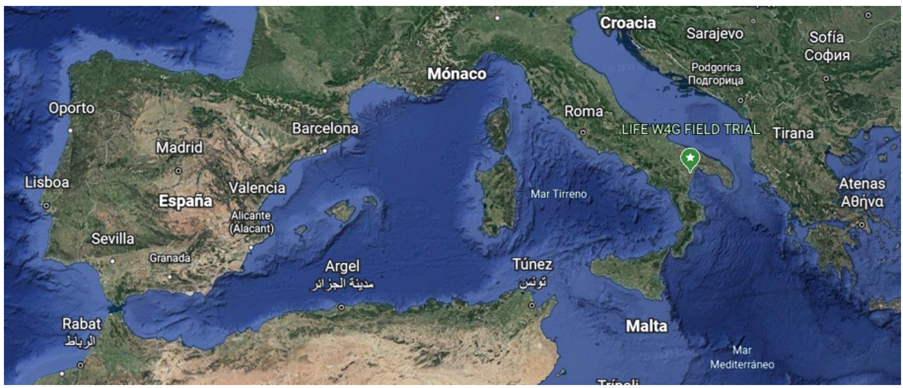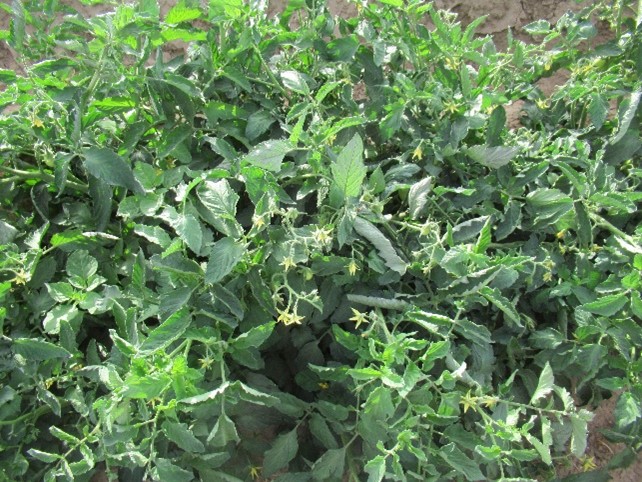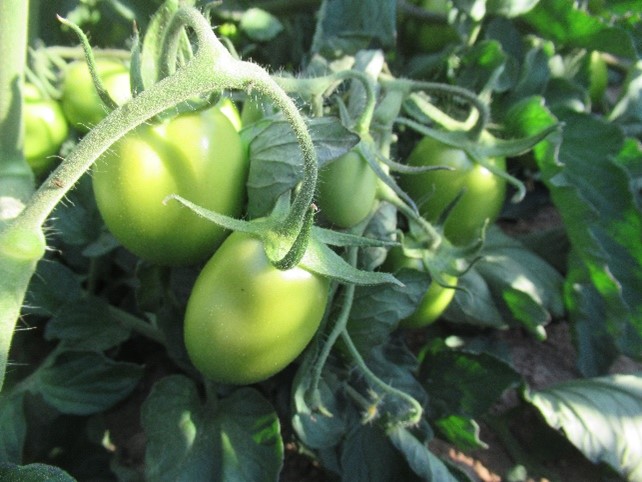B5 Demonstration of the replicability of formulations in commercial plots
The aim of this action is to demonstrate that these products can be used in other stone fruit producing areas of the European Union, and even on other crops, such as industrial tomatoes. To this end, agronomic trials have been carried out in Portugal (FRUTUGA), Italy (IDAI NATURE) and on another crop, the industrial tomato (CTAEX).
Validation of the effectiveness of WASTE4GREEN products in PORTUGAL
With the aim of demonstrating the replicability of the use of the new Waste4Green biopesticides in stone fruit crops (apricot, nectarine and plum) in another EU country (Portugal), comparing them with other pesticide and fungicide products with active ingredients of chemical origin, the agronomic results obtained in the 2022 season on FRUTUGA's apricot, nectarine and plum orchards in its commercial farms in Santa Vitoria (Beja, Portugal) are presented below.



Nectarine (left), apricot (centre) and plum (right) trees at locations in Portugal
In the apricot crop, at the trial location and only for the season 2022:
1. In the 2022 season there has been very little incidence of pests and diseases in the FRUTUGA apricot crop, with no differences between the theses tested.
2. At the nutritional level during the crop cycle, there were no differences in chlorophyll levels or macronutrient levels in apricot trees treated with the project's formulations (eucalyptus and alpeorujo) compared to those treated with chemical products, and in general, neither in micronutrient levels.
3. The total productivity (gross yield, kg/ha) of the apricot trees was not affected by the application of the project formulations (eucalyptus and alpeorujo), obtaining similar yields to the control thesis, with conventional treatments.
4. On the quality parameters evaluated on suitable apricot fruit:
a. Total water-soluble vitamin content was higher in apricots treated with Waste4Green formulations compared to the control, mainly due to higher concentrations of thiamine (vitamin B1) and niacin (vitamin B3).
b. The treatments carried out on the apricot crop did not result in changes in the acidity of the fruit and its firmness, although there was a lower ºBrix and lower Maturity Index in the fruit of the trees treated with the formulations of the project, compared to the control.
c. The instrumental colour of the fruit was affected by the treatments, with higher values of L*, a* and b* in the fruit from trees treated with Waste4Green formulations compared to the control.
5. No pesticide residues were detected in any of the apricot fruit samples, neither in the control thesis nor in the thesis in which the products developed in the project were applied.


Treatment carried out on plum (left) and nectarine (right) crops
In the nectarine crop, at the trial location and only for the 2022 season:
1. In the 2022 season there has been very little incidence of pests and diseases in the FRUTUGA nectarine crop, with no differences between the theses tested.
2. At the nutritional level during the crop cycle, there were no differences in the chlorophyll levels of the nectarine trees treated with the project formulations (eucalyptus and alpeorujo) with respect to those treated with chemical products, and in general, neither in the levels of macronutrients and micronutrients.
3. The total productivity (gross yield, kg/ha) of the nectarine trees on which the project formulations (eucalyptus and alpeorujo) were applied was significantly higher (9533 kg/ha) than the yield obtained on trees treated with conventional plant protection products (6312 kg/ha).
4. On the quality parameters evaluated on suitable nectarine fruit:
a. Total water-soluble vitamin content was higher in nectarines treated with Waste4Green formulations compared to the control, mainly due to higher concentrations of pantothenic acid (vitamin B5) and pyridoxine (vitamin B6).
b. The treatments carried out on the nectarine crop did not result in changes in fruit acidity and firmness, although there was a lower ºBrix and lower Maturity Index in the fruit of the trees treated with the project formulations, compared to the control.
c. The instrumental colour of the fruit was affected by the treatments carried out, with lower L* and b* values and higher a* values in the fruit from trees treated with Waste4Green formulations compared to the control.
5. No pesticide residues were detected in any of the nectarine fruit samples, neither in the control thesis nor in the thesis in which the products developed in the project were applied.
|
Fruit harvested in one of the plum theses |
Measurement of firmness in peaches |
In the plum tree trial, at the trial location and only for the 2022 season:
1. In the 2022 season there has been very little incidence of pests and diseases in the FRUTUGA plum crop, with no differences between the theses tested.
2. At the nutritional level during the crop cycle, there were no differences in the chlorophyll levels of the plum trees treated with the project formulations (eucalyptus and alpeorujo) with respect to those treated with chemical products, and in general, neither in the levels of macronutrients and micronutrients.
3. The total productivity (gross yield, kg/ha) of plum trees on which the project formulations (eucalyptus and alpeorujo) were applied was significantly higher (6851 kg/ha) than the yield obtained on trees treated with conventional plant protection products (2548 kg/ha).
4. On the quality parameters assessed on suitable plum fruit:
a. The total content of water-soluble vitamins was lower in plums treated with Waste4Green formulations compared to the control, mainly due to lower concentrations of pantothenic acid (vitamin B5), although, unlike the control, thiamine (vitamin B1) was detected in these fruits.
b. The treatments carried out on the plum crop resulted in lower fruit acidity, lower ºBrix, higher Maturity Index and greater firmness in the fruit of the trees treated with the project formulations, compared to the control.
c. Instrumental fruit colour was affected by the treatments, with lower L*, a* and b* values in fruit from trees treated with Waste4Green formulations compared to the control.
5. No pesticide residues were detected in any of the plum fruit samples, neither in the control thesis, nor in the thesis in which the products developed in the project were applied.
Validation of the efficacy of WASTE4GREEN products in ITALY
Trials were carried out as a fungicide and insecticide on nectarine in Italy, comparing them with other crop protection products with synthetic active substances.
Conclusions
A replication trial was conducted on 2 ha of Prunus persica cv. nucipersica (Nectarine) in southern Italy. The formulations were applied to evaluate their biofungicidal and bioinsecticidal activity, comparing them with commercial synthetic products. Pests and diseases were monitored, as well as nutritional and agronomic parameters of the crop and quality descriptors of the fruit obtained.

Trial location (Italy, Southern Europe)


Location of the trial in the municipality of Marconia (Basilicata Region, Italy) and plot details.
In this trial, the formulations based on Eucalyptus and Alperujo were applied at the lowest dose with effect previously tested in the experimental farm of AVA-ASAJA (7 l/ha). The theses tested with the Waste4Green formulations were compared with: 1) a chemical thesis that corresponds to an integrated pest and disease management strategy, which usually uses chemically synthesised phytosanitary products, and 2) a control thesis, without treatment, where only water is applied.
Summary table of the trial application design. Timing corresponds to the #BBCH (phenological stage).


Field application of W4G formulations. First application, 14 April 2022
The planning and execution of the field trial focused on the application of the new formulations, monitoring and evaluation of pests and diseases, supervision of the correct development of the crop cycle (fertilisation, irrigation, pruning, etc.), physiological and nutritional monitoring of the crops (leaves and fruit), harvesting and obtaining agronomic yield parameters (gross yield (kg/ha), net yield (acceptable raw material, kg/ha and %).), physiological and nutritional monitoring of the crops (leaves and fruit), harvesting and obtaining agronomic yield parameters (gross yield (kg/ha), net yield (acceptable raw material, kg/ha and %), green or unripe fruit (%), overripe fruit (%), diseased fruit (%) and average fruit weight (g)) and obtaining technological parameters by analysing the quality of the marketable fruit (°brix, acidity and texture or firmness).
Summary table of target pests and diseases

Conclusions
In general, very positive results have been obtained. In the control of pests and diseases, the formulations have shown similar levels of efficacy, and in some cases higher than the chemical phytosanitary products normally used. This efficacy has been translated into a maintenance of agronomic yields and fruit quality.
The most salient findings of the trial are listed below:
- The eucalyptus-based formulation showed similar behaviour to the chemical thesis, where systemic insecticides were used to control Myzus persicae. The effect of alperujo was less noticeable.
- There was no incidence of thrips in the trial.
- The chemical thesis treatments for Taphrina deformans were not able to fully control the disease. The alperujo exhibited similar behaviour to the chemical thesis, so it may be of interest as a possible biofungicide.

Details of damage observed during the assessments
- The chemical treatments applied to combat Monillinia sp. did not slow down its advance during the trial. The efficacy of the experimental products applied in treatments 2 and 3 was lower than the efficacy shown by treatment 4 (chemical strategy).
- At a nutritional level during the crop cycle, and in general, the ratio between the 3 elementary macronutrients N+P+K is nutritionally insufficient or low. On the other hand, the ratio between (K+Ca+Mg) showed sufficient - optimal levels for the correct development of the crop.
- The gross yield of the crop was between 4500 and 4050 kg/ha, with thesis 1 (control) having the highest gross yield, followed by theses 2 and 3 (formulated with alperujo and eucalyptus at 7 L/ha, respectively). Thus, the thesis with the lowest gross yield was thesis 4 with chemicals.
- The net yield was 2500 - 3650 kg/ha, with the highest acceptable raw material obtained in thesis 4 (chemical), followed by the theses in which the experimental formulations, 2 and 3, were applied. In thesis 1 (control) a lower net yield was obtained.
- For the quality parameters evaluated (°Brix, acidity, maturity index and firmness) on the suitable fruit, no differences were observed between the different theses.

Fruit harvested at the end of the trial
Validation of the efficacy of WASTE4GREEN products on PROCESSING TOMATO
Processing tomato could be an interesting sector in which to transfer the results of the project, due to their importance and the crop's sensitivity to pests and diseases. In 2022, 37,269 million kilos of processing tomato were produced worldwide. This represents a decrease of 4.9% compared to 2021, cutting the rise in production that had been occurring since 2018. The four main producing countries are the United States, Italy, China and Spain. World tomato production has increased significantly since 2001, from just over 25 billion kg to the current 37,269 million kg, passing through the peak of 44,512 in 2009.
In order to demonstrate the transferability of the use of the new Waste4Green biopesticides in crops other than stone fruit trees, specifically in processing tomato, by comparing them with other pesticide and fungicide products with active ingredients of chemical origin, the results obtained are presented below.

CTAEX experimental farm and location of the trial on processing tomato

General view of the processing tomato trial

Processing tomato treatment, with synergy formulated (17/06/2022)


Test field W4G (formulated), after 19 days after transplanting


Test field W4G (formulated), after 31 days after transplanting


Test field W4G (formulated), after 42 days after transplanting

General view of the trial, 48 days after transplantation


Test field W4G (formulated), after 48 days after transplanting


Test field W4G (formulated), after 62 days from transplanting


Test field W4G-CM (formulated with a single chemical treatment), 72 days after transplanting

Manual harvesting of a test replicate

Total harvested in one of the replications

Chlorophyll measurement with SPAD-502Plus


Removal of unsuitable tomatoes (left) and sorting by size (right)
In the trial carried out on the processing tomato crop, at the trial location and only for the 2022 season:
1. Compared to the Integrated Production control, the application of the project formulations (eucalyptus, alperujo and synergy) has achieved similar control against rosquilla (Spodoptera spp.), heliothis (Helicoverpa armígera), whitefly (Bemisia tabaci), and bacterial spots (Xanthomonas spp.), even with the total substitution of chemical pesticides.
2. Red spider mite (Tetranychus urticae) populations could not be fully controlled this season in the trial (not even in the control), although the application of the eucalyptus formulation seems to achieve better control than the rest of the products applied.
3. Total substitution of chemical pesticides does not achieve control of vasates (Aculops lycopersici) on processing tomato, and at least a single treatment with the chemical active substance spirotetramat is necessary.
4. With the application of Waste4Green formulations (eucalyptus, alperujo and synergy) a better development of the processing tomato plants is achieved (percentage of coverage on the seedbed).
5. At the nutritional level, with the application of the project's formulations (eucalyptus, alperujo and synergy), a similar nutritional state of the plants has been achieved in comparison with the Integrated Production control (chlorophyll content of the leaves, and assimilation of macro- and micronutrients).
6. The gross yields obtained in the sectors where the Waste4Green formulations were applied were higher than those obtained in the iIntegrated Production control, although the differences were not statistically significant.
7. The acceptable raw material (net yield, kg/ha) was higher in the processing tomato sector where the project formulations (eucalyptus, alperujo and synergy) were applied together with a single active material of chemical origin (spirotetramat) (B5T-W4G CM, 81.111 kg/ha), compared to the Integrated Production control (B5T-TST, 66,167 kg/ha) and the sector with 100% substitution of chemical pesticides (B5T-W4G SM, 56,500 kg/ha).
8. The rest of the agronomic parameters evaluated (average fruit weight, percentage of green fruit, percentage of overripe fruit, percentage of diseased fruit, percentage of blighted fruit and percentage of fruit with apical necrosis) were not influenced by the treatments with Waste4Green formulations (eucalyptus, alperujo and synergy), in comparison with the tesitigo, which was treated with chemical phytosanitary products.
9. In the quality parameters evaluated on suitable processing tomato fruits (ºBrix, pH, viscosity, firmness and instrumental colour), in general, no differences were found between tomatoes with 100% substitution of chemical pesticides (B5T-W4G SM), with those treated with the project formulations and with a single chemical treatment (B5T-W4G CM), and with tomatoes from the sector treated with pesticides of chemical origin (B5T-TST).
10. Pesticide residue analyses carried out on the acceptable raw material of processing tomato did not detect the presence of active substances of chemical origin, not even in tomatoes from the Integrated Production sector.


